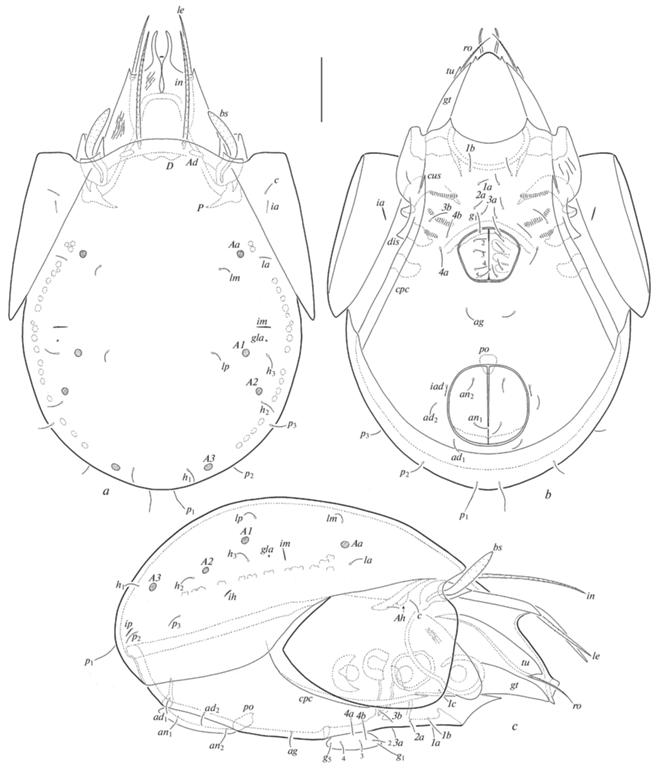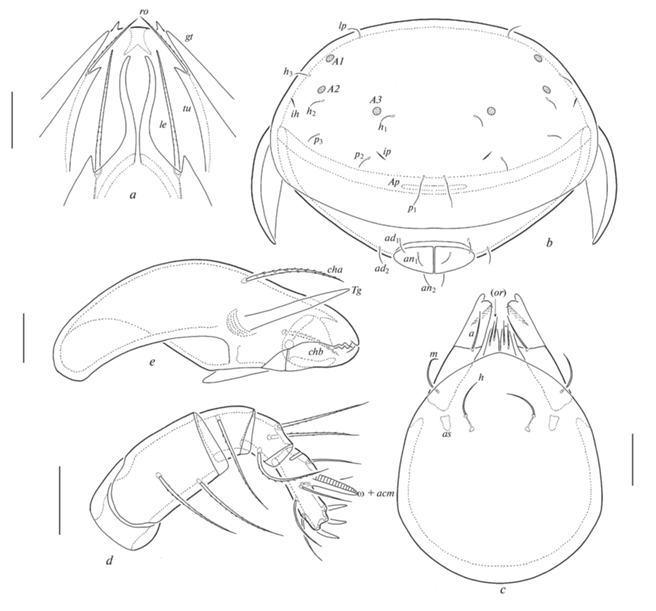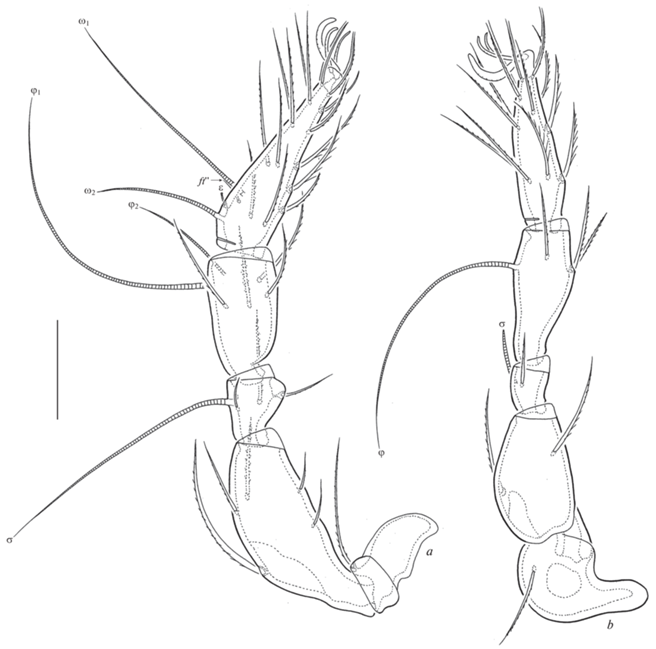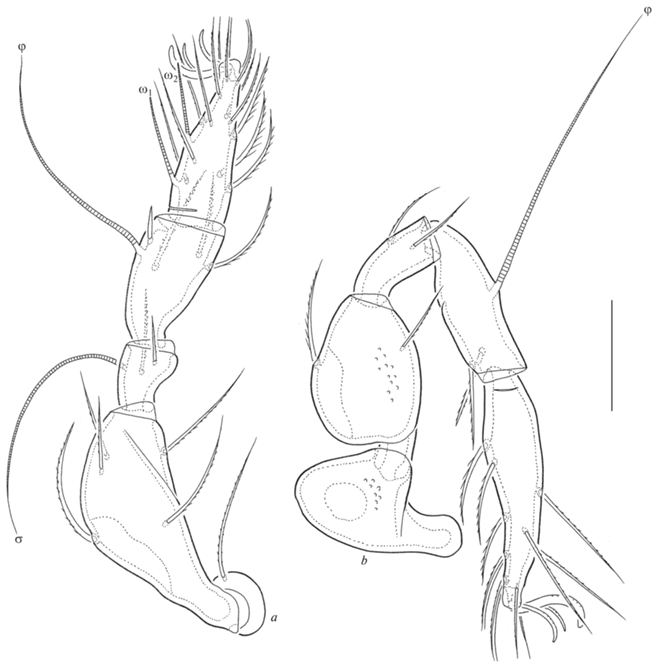Зоологический журнал, 2022, T. 101, № 10, стр. 1107-1114
Contribution to the knowledge of the Oribatid mite genus Arcozetes Hammer 1958 (Acari, Oribatida, Ceratokalummidae), with the description of a new species from Peru
S. G. Ermilov a, *, L. S. Subías b, **, U. Ya. Shtanchaeva b, ***
a Tyumen State University
625003 Tyumen, Russia
b Complutense University
28040 Madrid, Spain
* E-mail: ermilovacari@yandex.ru
** E-mail: subias@bio.ucm.es
*** E-mail: umukusum@mail.ru
Поступила в редакцию 10.09.2021
После доработки 30.10.2021
Принята к публикации 31.10.2021
- EDN: DMHQGE
- DOI: 10.31857/S0044513422080050
Аннотация
A new species of the genus Arcozetes (Oribatida, Ceratokalummidae) is described, based on material collected from Peru. In addition, the generic traits, as well the distribution of and habitat data for the known species of Arcozetes are presented.
The oribatid mite genus Arcozetes of the family Ceratokalummidae (Acari, Oribatida) was proposed by Hammer (1958) with Arcozetes bicuspidatus Hammer 1958 as type species. At present, the genus comprises two species that are known from the Neotropical region (Subías, 2004, online version 2021).
During our taxonomic identification of Peruvian mites (Neotropical region), we found a new species of Arcozetes (making it the third identified representative). The goals of this paper are: to describe and illustrate the new species; to present an updated generic diagnosis; to provide the distribution and habitat data on the known species of Arcozetes.
METHODS
Observation and documentation. Specimens were mounted in lactic acid on temporary cavity slides for measurement and illustration. Body length was measured in lateral view, from the tip of the rostrum to the posterior edge of the notogaster. Notogastral width refers to the maximum width of the notogaster (behind pteromorphs) in dorsal view. Lengths of body setae were measured in lateral aspect. All body measurements are presented in micrometers. Formulas for leg setation are given in parentheses according to the sequence trochanter-femur-genu-tibia-tarsus (famulus included). Formulas for leg solenidia are given in square brackets according to the sequence genu-tibia-tarsus. Drawings were made with a camera lucida using a Leica transmission light microscope “Leica DM 2500”.
Terminology and conventions. Morphological terminology used in this paper mostly follows that of F. Grandjean: see Travé and Vachon (1975) for references, Norton (1977) for leg setal nomenclature, and Norton and Behan-Pelletier (2009) for overview.
Abbreviations and notations. Prodorsum: ro, le, in, bs = rostral, lamellar, interlamellar, and bothridial seta, respectively; D = dorsophragma; P = = pleurophragma; tu = tutorium; Ad = dorsosejugal porose area. Notogaster: Aa, A1, A2, A3 = porose areas; c, la, lm, lp, h, p = setae; ia, im, ip, ih = lyrifissures; gla = opisthonotal gland opening. Gnathosoma: a, m, h = subcapitular setae; or = adoral seta; as = = axillary saccule; ω = palp solenidion; cha, chb = cheliceral setae; Tg = Trägårdh’s organ. Epimeral and lateral podosomal regions: 1a, 1b, 1c, 2a, 3a, 3c, 4a, 4b = = epimeral setae; Ah = humeral porose area; gt = genal tooth; dis = discidium; cpc = circumpedal carina. Anogenital region: g, ag, an, ad = genital, aggenital, anal, and adanal seta, respectively; iad = adanal lyrifissure; Ap = postanal porose area; po = preanal organ. Legs: Tr, Fe, Ge, Ti, Ta = trochanter, femur, genu, tibia, tarsus, respectively; ω, φ, σ = solenidia; ɛ = famulus; ft = seta.
TAXONOMY
Generic traits of Arcozetes (adult)
With character states of the Ceratokalummidae (Balogh, Balogh, 1988; Norton, Behan-Pelletier, 2009). Size. Small, length less than 300. Integument. Without heavy sculpturing and ornamentation. Prodorsum. Rostrum bidentate. Lamellae narrow, their cusps short, connected medially, with short outer tooth and long inner tooth. Translamella absent. Rostral, lamellar and interlamellar setae well developed. Bothridium with scales. Dorsophragmata fused medially. Tutorium with triangular tip. Dorsosejugal porose area present. Notogaster. Pteromorph rounded laterally, without anterior projection. Octotaxic system as four pairs of small porose areas. Notogastral setation: 10 pairs of short, setiform setae. Posterior notogastral tectum developed. Gnathosoma. Subcapitulum diarthric, “galumnid” type. Axillary saccule present. Palp setation: 0–2–1–3–9(+ω). Solenidion bacilliform, attached to eupathidium along length. Lateral podosomal and epimeral regions. Genal tooth elongate triangular. Pedotectum I as a large lamina. Custodium, discidium and circumpedal carina present. Humeral porose area Ah present, Am not observed. Epimeral setal formula: 3–1–2–2. Anogenital region. Five pairs of genital, one pair of aggenital, two pairs of anal, and two pairs of adanal setae. Postanal porose area present. Legs. All leg tarsi with three claws. Porose area present on femora I–IV and trochanters III, IV.
Arcozetes longicornutus Ermilov, Subías et Shtanchaeva sp. n. (Figs 1–4)
Fig. 1.
Arcozetes longicornutus sp. n., adult: a – dorsal view, b – ventral view (gnathosoma and legs not shown), c – lateral view (gnathosoma and legs not shown). Scale bar 50 µm.

Fig. 2.
Arcozetes longicornutus sp. n., adult: a – anterior part of prodorsum, dorsoanterior view; b – posterior view; c – subcapitulum, ventral view; d – palp, right, antiaxial view; e – chelicera, left, paraxial view. Scale bar (μm): a – 20; b – 50; c–e – 10.

Fig. 3.
Arcozetes longicornutus sp. n., adult: a – leg I, right, antiaxial view; b – leg III, left, antiaxial view. Scale bar 20 µm.

Fig. 4.
Arcozetes longicornutus sp. n., adult: a – leg II, right, antiaxial view; b – leg IV, left, antiaxial view. Scale bar 20 µm.

Material. Holotype (♀) and six paratypes (2♂♂, 4♀♀): South America, Amazonian Peru, 09°37′ S, 74°56′ W, Huánuco Department, Puerto Inca Province, Yuyapichis District, Área de Conservación Privada, Panguana (biological field station), near Rio Yuyapichis (river), 230–260 m a.s.l., upper soil and leaf litter in the primary evergreen lowland rainforest, 23.IV.2016–09.V.2016 (S. Friedrich, F. Wachtel and D. Hauth). Mites were extracted using Winkler’s apparatus in laboratory conditions during 10 days from samples into 75% ethanol.
The holotype is deposited in the Museo de Historia Natural, Universidad Nacional Mayor de San Marcos, Lima, Peru; six paratypes are deposited in the Tyumen State University Museum of Zoology, Tyumen, Russia. All specimens are preserved in ethanol with a drop of glycerol.
Diagnosis. Body size: 215–249 × 149–166. Inner teeth of lamellar cusps bent in median part. Rostral seta long, setiform, barbed; lamellar and interlamellar setae slightly thickened, straight, barbed; in longest. Bothridial seta with short stalk and long, narrowly elongate, fusiform head. Notogastral, epimeral and anogenital setae short, setiform, thin, smooth; p1 longer than others. All notogastral porose areas small, rounded. Postanal porose area narrowly elongate oval. Leg seta l '' on tibia II thorn-like.
Description. Measurements. Body length: 249 (holotype), 215–249 (paratypes); notogaster width: 166 (holotype), 149–166 (paratypes). No differences between males and females in body size.
Integument. Body colour light brown to brown. Surface nearly smooth. Lamella and pedotectum I slightly striate.
Prodorsum. Rostrum bidentate (visible in anterodorsal view), teeth strong. Distal part of lamella with two well-developed teeth (outer tooth short, triangular; inner tooth long, thorn-like, slightly bent in median part) and deep U-shaped indentation between them. Rostral seta (28–32) setiform, barbed. Lamellar (41–45) and interlamellar (65–69) setae slightly thickened, straight, barbed. Bothridial seta (36–41) fusiform, with short stalk and elongate, slightly barbed, narrowed distally head. Exobothridial seta not observed. Dorsosejugal porose area diffuse.
Notogaster. Anterior margin slightly convex medially. Pteromorph rounded laterally. Ten pairs of notogastral setae (p1: 16; others: 8) setiform, thin, smooth. Porose areas rounded (4–6). Opisthonotal gland opening and all lyrifissures distinct (except ips not observed).
Gnathosoma. Subcapitulum size: 57–61 × 41–45. Subcapitular setae (a, m, h: 10–12) and adoral (6) setae setiform, thin, smooth. Palp (length: 41–45) with setation 0–2–1–3–9(+ω). Postpalpal seta (4) spiniform, smooth. Axillary saccule distinct, slightly elongated. Chelicera length: 61–65. Cheliceral setae (cha: 16; chb: 12) setiform, barbed.
Epimeral and lateral podosomal regions. Epimeral setae (1a, 1c, 2a, 3a: 8; others: 12) setiform, thin, smooth. Discidium triangular. Circumpedal carina long, reaching epimere I, distally connected with custodium. Humeral porose area Ah oval, poorly visible.
Anogenital region. Genital (g1: 16; others: 8), aggenital (8), anal (8), and adanal (8) setae setiform, thin, smooth. Adanal lyrifissure distinct. Postanal porose area narrowly elongate oval, poorly visible.
Legs. All claws slightly barbed on dorsal side. Porose area on femora I–IV and on trochanters III, IV present, but poorly visible. Formulas of leg setation and solenidia: I (1–5–3–4–20) [1–2–2], II (1–5–2–4–15) [1–1–2], III (1–2–1–3[2 ] –15) [1–1–0], IV (0–2–2–2–12) [0–1–0]; homology of setae and solenidia indicated in Table 1. Famulus of tarsus I short, stick-like, slightly swollen and blunt-ended apically, inserted between solenidia ω1 and ω2. Seta s of tarsus I eupathidial, located before setae a. Seta l '' on tibia II thorn-like. Solenidia ω1, ω2 on tarsus II and σ on genu III thickened, distally rounded; other solenidia setiform.
Table 1.
Leg setation and solenidia of adult Arcozetes longicornutus sp. n.
| Leg | Tr | Fe | Ge | Ti | Ta |
|---|---|---|---|---|---|
| I | v' | d, (l), bv '', v'' | (l), v ', σ | (l), (v), φ1, φ2 | (ft), (tc), (it), (p), (u), (a), s, (pv), v', (pl), l '', ɛ, ω1, ω2 |
| II | v' | d, (l), bv '', v'' | (l), σ | (l), (v), φ | (ft), (tc), (it), (p), (u), (a), s, (pv), ω1, ω2 |
| III | l ' | d, ev' | l ', σ | l ', (v), φ | (ft), (tc), (it), (p), (u), (a), s, (pv) |
| IV | – | d, ev' | d, l ' | (v), φ | ft'', (tc), (p), (u), (a), s, (pv) |
Remarks. Arcozetes longicornutus sp. n. differs from the other members of Arcozetes in the morphology of the following characters: lamellar cusp, head of bothridial seta and setae le and in. The new species also differs from the other members of the genus in the length of its body and in the length of its notogastral setae (Table 2).
Table 2.
Distinctive morphological characters of Arcozetes spp.
| Character | A. bicuspidatus | A. rotundatus | A. longicornutus |
|---|---|---|---|
| Inner teeth of lamellar cusps | Medium size, straight, parallel | Medium size, straight, parallel | Long, slightly bent in median part |
| Head of bothridial seta | Elongate fusiform, distally with short setiform tip | Elongate clavate, distally rounded | Elongate fusiform, distally narrowed |
| Setae le and in | Setiform | Setiform | Slightly thickened |
| Body length | 270 | 240–255 | 215–249 |
| Notogastral setae | Similar in length | Similar in length | p1 longer than others |
Etymology. The specific name refers to the long inner tooth of the lamellar cusp.
DISTRIBUTION OF ARCOZETES
The species of Arcozetes are known only from the Neotropical region (Subías, 2004, online version 2021). The type species, A. bicuspidatus was described from Argentina in slightly moist liverworts, on a slope leading down to a deep dry arroyo, shaded by shrubs, at Quebrada de Gallinato, near Salta (Hammer, 1958). Later, it was recorded from Bolivia: 1) in moss growing in a steep rocky declivity, shaded by vegetation, between Alcoche and Puerto Linares, Alto Beni region, and 2) in moss growing on a roadside cliff, 25 km from Alcoche, Alto Beni region (Balogh, Mahunka, 1969). This species was also recorded from Peru (Hammer, 1961): 1) in low green moss on the vertical side of a water drain, located along the road, below a tall Eucalyptus tree, at the site of Cajamarca; 2) in a one-centimeter-high luxurious moss, in oozing water, below shrubs, at Tambomachay; 3) in moist moss and liverworts growing on walls, in wet moss growing in oozing water on a cliff, and it was very common in thin moist moss on the ground – all at Machu Picchu. A. bicuspidatus was also recorded from Ecuador: 1) in moss growing on shrubs and tree branches, about 10 m above the Alamo River, 6 km from Nono; 2) in litter and soil, as well as in the debris and moss cover associated with a decomposing tree stump, in a forest patch located on the way to San Francisco de las Pampas, Guayas Province (Balogh, 1988); 3) in a moist vegetation zone, on the Galapagos archipelago (Schatz, 1998).
Arcozetes rotundatus was described from Venezuela: “in and around a forest stream litter and soil” located in a seasonal rain forest at Parque Nacional Henri Pittier (Mahunka, 2006). Also, it was recorded by us from Peru (first record of this species in this country) in the upper soil and leaf litter, in the primary evergreen lowland rainforest, Churubamba District, Huánuco Province.
The new species, A. longicornutus was sampled from Peru: in the upper soil and leaf litter, in the primary evergreen lowland rainforest located in Panguana (Área de Conservación Privada), near Rio Yuyapichis, Yuyapichis District, Puerto Inca Province.
Additionally, one unknown species of Arcozetes was recorded from Panama: in moss and ferns, in the tropical wet forest, Cerro Gaital Mountains, near El Valle de Antón, Cordillera Central (Schatz, 2006).
Список литературы
Balogh J., Balogh P., 1988. The family Ceratokalummidae Balogh, 1970 (Acari, Oribatei) // Acta Zoologica Academiae Scientiarum Hungaricae. V. 34. № 2–3. P. 191–201.
Balogh J., Mahunka S., 1969. The zoological results of the Hungarian soil zoological expeditions to South America. 11. Acari: oribatids from the material of the second expedition, II // Opuscula Zoologica Budapest. V. 9. № 1. P. 31–69.
Balogh P., 1988. Oribatid mites from Ecuador (Acari) // Acta Zoologica Hungarica. V. 34. № 4. P. 321–338.
Hammer M., 1958. Investigations on the oribatid fauna of the Andes Mountains. I. The Argentine and Bolivia // Det Kongelige Danske Videnskabernes Selskab Biologiske Skrifter. V. 10. № 1. P. 1–129.
Hammer M., 1961. Investigations on the oribatid fauna of the Andes Mountains. II. Peru // Det Kongelige Danske Videnskabernes Selskab Biologiske Skrifter. V. 13. № 1. P. 1–157.
Mahunka S., 2006. Oribatid mites (Acari, Oribatida) from Venezuela. II. New or rare species from montane forests // Acta Zoologica Hungarica. V. 52. № 3. P. 271–286.
Norton R.A., 1977. A review of F. Grandjean’s system of leg chaetotaxy in the Oribatei (Acari) and its application to the family Damaeidae // In: Dindal D.L., editor. Biology of oribatid mites. Syracuse, SUNY College of Environmental Science and Forestry. P. 33–61.
Norton R.A., Behan-Pelletier V.M., 2009. Oribatida // A Manual of Acarology (TX). Lubbock: Texas Tech University Press. P. 430–564.
Schatz H., 1998. Oribatid mites of the Galápagos Islands – faunistics, ecology and speciation // Experimental and Applied Acarology. V. 22. P. 373–409.
Schatz H., 2006. Catalogue of known oribatid mite species (Acari Oribatida) from the Central American landbridge (First part) // Tropical Zoology. V. 19. V. 209–288.
Subías L.S., 2004. Listado sistemático, sinonímico y biogeográfico de los ácaros oribátidos (Acariformes, Oribatida) del mundo (1758–2002) // Graellsia. № 60. P. 3–305.
Subías L.S., 2021. Listado sistemático, sinonímico y biogeográfico de los ácaros oribátidos (Acariformes: Oribatida) del mundo (excepto fósiles). 16a actualización. Online version accessed in March 2021. 532 p. http://bba.bioucm.es/cont/docs/RO_1.pdf
Travé J., Vachon M., 1975. François Grandjean. 1882–1975 (Notice biographique et bibliographique) // Acarologia. V. 17. № 1. P. 1–19.
Дополнительные материалы отсутствуют.
Инструменты
Зоологический журнал


